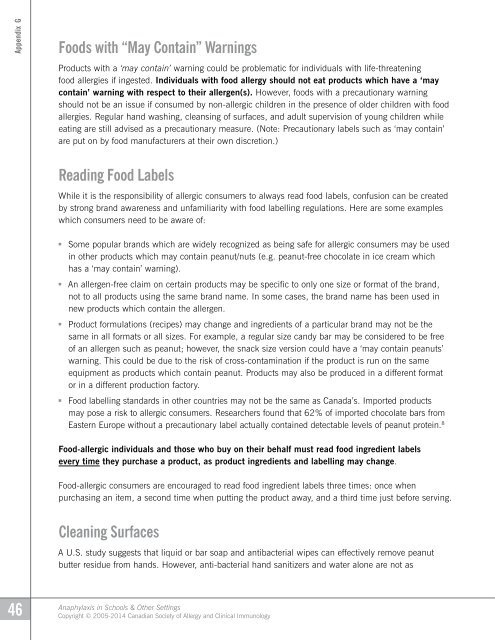Anaphylaxis in Schools 3rd Edition
Anaphylaxis in Schools 3rd Edition
Anaphylaxis in Schools 3rd Edition
You also want an ePaper? Increase the reach of your titles
YUMPU automatically turns print PDFs into web optimized ePapers that Google loves.
Appendix G<br />
Foods with “May Conta<strong>in</strong>” Warn<strong>in</strong>gs<br />
Products with a ‘may conta<strong>in</strong>’ warn<strong>in</strong>g could be problematic for <strong>in</strong>dividuals with life-threaten<strong>in</strong>g<br />
food allergies if <strong>in</strong>gested. Individuals with food allergy should not eat products which have a ‘may<br />
conta<strong>in</strong>’ warn<strong>in</strong>g with respect to their allergen(s). However, foods with a precautionary warn<strong>in</strong>g<br />
should not be an issue if consumed by non-allergic children <strong>in</strong> the presence of older children with food<br />
allergies. Regular hand wash<strong>in</strong>g, cleans<strong>in</strong>g of surfaces, and adult supervision of young children while<br />
eat<strong>in</strong>g are still advised as a precautionary measure. (Note: Precautionary labels such as ‘may conta<strong>in</strong>’<br />
are put on by food manufacturers at their own discretion.)<br />
Read<strong>in</strong>g Food Labels<br />
While it is the responsibility of allergic consumers to always read food labels, confusion can be created<br />
by strong brand awareness and unfamiliarity with food labell<strong>in</strong>g regulations. Here are some examples<br />
which consumers need to be aware of:<br />
• Some popular brands which are widely recognized as be<strong>in</strong>g safe for allergic consumers may be used<br />
<strong>in</strong> other products which may conta<strong>in</strong> peanut/nuts (e.g. peanut-free chocolate <strong>in</strong> ice cream which<br />
has a ‘may conta<strong>in</strong>’ warn<strong>in</strong>g).<br />
• An allergen-free claim on certa<strong>in</strong> products may be specific to only one size or format of the brand,<br />
not to all products us<strong>in</strong>g the same brand name. In some cases, the brand name has been used <strong>in</strong><br />
new products which conta<strong>in</strong> the allergen.<br />
• Product formulations (recipes) may change and <strong>in</strong>gredients of a particular brand may not be the<br />
same <strong>in</strong> all formats or all sizes. For example, a regular size candy bar may be considered to be free<br />
of an allergen such as peanut; however, the snack size version could have a ‘may conta<strong>in</strong> peanuts’<br />
warn<strong>in</strong>g. This could be due to the risk of cross-contam<strong>in</strong>ation if the product is run on the same<br />
equipment as products which conta<strong>in</strong> peanut. Products may also be produced <strong>in</strong> a different format<br />
or <strong>in</strong> a different production factory.<br />
• Food labell<strong>in</strong>g standards <strong>in</strong> other countries may not be the same as Canada’s. Imported products<br />
may pose a risk to allergic consumers. Researchers found that 62% of imported chocolate bars from<br />
Eastern Europe without a precautionary label actually conta<strong>in</strong>ed detectable levels of peanut prote<strong>in</strong>. 8<br />
Food-allergic <strong>in</strong>dividuals and those who buy on their behalf must read food <strong>in</strong>gredient labels<br />
every time they purchase a product, as product <strong>in</strong>gredients and labell<strong>in</strong>g may change.<br />
Food-allergic consumers are encouraged to read food <strong>in</strong>gredient labels three times: once when<br />
purchas<strong>in</strong>g an item, a second time when putt<strong>in</strong>g the product away, and a third time just before serv<strong>in</strong>g.<br />
Clean<strong>in</strong>g Surfaces<br />
A U.S. study suggests that liquid or bar soap and antibacterial wipes can effectively remove peanut<br />
butter residue from hands. However, anti-bacterial hand sanitizers and water alone are not as<br />
46<br />
<strong>Anaphylaxis</strong> <strong>in</strong> <strong>Schools</strong> & Other Sett<strong>in</strong>gs<br />
Copyright © 2005-2014 Canadian Society of Allergy and Cl<strong>in</strong>ical Immunology


